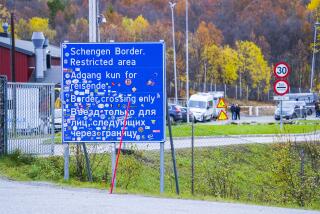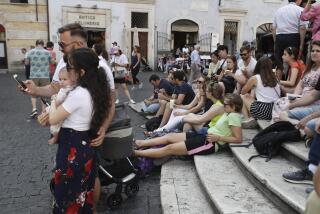FIORD EXPLORERS
- Share via
BERGEN, Norway — It was not a promising start. As when I plan any trip, I began research on Norway with a visit to the library in search of literature, guidebooks and anecdotal writings. What little I found basically concluded that Norway was dull and expensive.
This was exactly what my husband, Shu-Ming, had said when I first proposed the idea of a driving tour of Norway’s fiord region. He had hoped for a trip with vivid culture, one in which every experience would reinforce just how far away from home we were.
“How about Rome?” he asked, as our kitchen table disappeared beneath maps and ferry schedules. “I hear that the sun in Tuscany is mellow and warm in September.”
Despite his limited enthusiasm and my fears that our 2 1/2-year-old daughter, Zoe, would not cope well with so much time in the car, I persevered. I had always wanted to visit Norway, and when we moved to London six years ago, I knew it was the perfect opportunity. With a child, it seemed an excellent vacation: no must-see cathedrals or ruins, just relaxation and beautiful scenery.
I designed a seven-day driving/ferry excursion beginning in Bergen, on Norway’s southwestern coast, heading north through the fiord towns of Balestrand, Loen and Geiranger. We ultimately continued on to Oslo via central Norway, but a circular route beginning and ending in Bergen is not too ambitious for a one-week excursion.
Having heard that hotels outside Norway’s larger cities were, in a word, basic, we decided to splurge in Bergen and stayed in one of the city’s most expensive. We chose the Admiral for its waterfront location and because we liked the idea that it was a converted warehouse.
We were delighted. The harbor view and small balcony that came with our mid-priced room for $105 per person (Zoe was free) included an abundant breakfast buffet. And when we expressed disappointment that Zoe’s bed would completely consume the sitting area, the staff quickly arranged for us to have an adjoining room at a reduced rate.
After checking into the Admiral, we took advantage of a clear Sunday afternoon (something of a rarity here) and rode the Floybanen, or funicular, that transports passengers 1,050 feet above sea level to a spot with a splendid view of the city and its huge harbor. From atop, the view is one of water virtually surrounding the city with fingers into its center. It’s easy to see why Bergen has remained Scandinavia’s busiest port since the Middle Ages.
*
After two days in Bergen we were ready to head north to the land of fiords. Although we could have traveled north by ferry, as many tourists do, we opted to rent a car in Bergen because of all the gear necessary to sustain our daughter. We knew we’d all be happiest if she had her own private backseat where she could spread out with books, toys and stuffed friends.
About an hour north of the city, we enjoyed one of Norway’s greatest roadway features: numerous picnic spots with dramatic vistas. We pulled off the road at the edge of a fiord where several picnic tables were positioned well apart from one another in a grassy field overlooking the water. As we feasted on steamed crab, pickled herring and boiled shrimp, all purchased at Bergen’s famous fish market, Torget, we decided that picnics of fresh seafood in this land of fishermen would be a mainstay of our journey.
By the end of our first day of driving, I no longer regretted not taking a no-effort fiord cruise, and was happy that we had decided to explore the fiords by auto, as the vast majority of travelers do. The driving, while challenging at times, was on well-tended two-lane roads that were totally clear of snow, as they usually remain between Memorial Day and the end of September. And our decision to rent a car provided an unexpected bonus: Some of the most memorable scenery of the trip came not from the fiords but from the interior landscape of mountains and farmland.
Just a few hours after our picnic, one of the prettiest drives of our trip occurred between Vinje (about 12 miles north of Voss) and Vik, where Route 13 follows a fiord through lush farmland, then climbs up to rugged landscape above the tree line.
It seemed we’d reached the top of the world when we drove along a lonely road with not a soul in sight and just a few boarded-up wooden cabins sprinkled among the rocks. A hotel clerk later explained to us that these cabins and the surrounding land were (and, in some cases, continue to be) owned by local families who stayed in the huts when they periodically came up to the mountains to tend their wild sheep.
Gradually as the road meandered down, lushness resumed until at last there was the first glimpse of the Sognefjord, a narrow slice of rich blue water cradled in more gently sloping hillsides than I had expected.
If limited time permits a visit to only one fiord, the Sognefjord is an excellent choice. Known as the king of fiords, it is the world’s longest and deepest, stretching more than 100 miles and nearly one mile deep. Thanks to the relatively mild climate of this region, the surrounding landscape is sprinkled with farms, fruit orchards and rich forests.
Despite several stops, including a pit stop for Zoe and a visit to the intricately carved wooden Hopperstad Stave Church in Vik, we reached our first ferry landing at Vangsnes in about 4 1/2 hours. We pulled into the nearly deserted parking lot where two rows of painted white lines each led to a different pier.
Needless to say, we had questions. Which row should we park in? Why were there two piers and which one was the correct one for Dragsvik, our destination?
We waited about 30 minutes when finally we saw a boat coming our way. We drove our car on and walked up to watch from on deck (the locals, unimpressed with the experience, waited in their cars). It was less than 10 minutes to Hella, where we changed boats and rode on to Dragsvik. From there we drove to Balestrand, arriving in time for dinner. Although the trip (including both ferry rides) cost only $10 per car, it taught us to travel with plenty of cash because crossings can cost as much as $35 and most ferries accept only cash.
We also later learned that had it been summer, we might have been stuck there all night. During the July and August high season, when fiord country roads are busy with Europeans, waits for ferries can be long. This isn’t a problem for shorter crossings; these serve in essence as extensions of the road system, and ferries make about 40 trips per day. But some of the longer routes have only a few boats daily, so it’s advisable to book ahead. (The Norwegian Tourist Board in New York advises reserving ahead for the popular Laerdal-Kaupanger-Gudvangen trip, which runs only four times a day.)
*
Many boats we took were small, with room for three or four tour buses, plus a local truck, allowing little space for private cars. But even as early as the first week of September, we rarely saw another car on the narrow mountain roads, and we often pulled into ferry landings with just five minutes to spare but still plenty of room for our little Volvo.
In the Sognefjord region, we stayed at Balestrand, a resort popular with the English in the early part of this century. Although the small town has many guest houses, cabins and campsites, we wanted to be assured of comfort and reserved a water view room at Kvikne’s Hotel, a grand old wooden lodge popular with tour groups. Our room, which cost about $100 per person without dinner, was simple but clean. It had a private bath, balcony and plenty of space for an extra bed.
The old building, an expansion of the original family house, is a fine example of the gingerbread architecture that symbolizes Norway’s Victorian age. The front is lined with balconies embellished with lace-like carving and eerie gables, the lawn and large stone pier curves into the fiord. Just a few steps away from the hotel is St. Olav’s Church, which was founded by an intrepid Englishwoman in the late 1800s.
In Balestrand we discovered how to truly enjoy the landscape. The hotel has a few rowboats tied to its dock. When we inquired at the desk, we were handed life jackets and oars. In just a few moments the three of us found ourselves floating in our humble craft, surrounded by looming gray and purple mountains.
This was the first time the Sognefjord took on the power that I had anticipated while planning our trip. As scenic and necessary as the ferries are, the loud engines and exclamations from other tourists detract from the experience. But bobbing around in the middle of the fiord in that tiny, plastic boat, I felt appropriately small and awed. This was the feeling I had come to Norway to experience.
*
We also took advantage of Balestrand’s proximity to some of Norway’s best sites and enjoyed several day trips.
One of our favorites was riding a ferry from Kaupanger through the Naeroyfjord, an arm of the Sognefjord and the narrowest fiord in Europe. Upon arrival in the port of Gudvangen, where there isn’t much but a souvenir shop, we drove about 15 miles--mostly through tunnels--to the tiny village of Flam. The town, built along the Aurlandsfjorden, is dominated by its train station, the starting point of the Flam Railway, one of Norway’s most dramatic rail excursions.
The 12 miles of narrow gauge track that climb 2,850 feet to the tiny settlement of Myrdal represent extraordinary engineering achievements. As the train creeps up the mountain closer to the edge than even a foolhardy goat would risk, it’s comforting to know that there are five sets of brakes on each carriage. It is particularly comforting when you learn that the trip includes 21 hairpin turns and several tunnels built along narrow ledges.
Swayed by literature from the Norwegian Tourist Board recommending a ferry ride on the Geirangerfjord, reputedly one of Norway’s prettiest fiords, we headed farther north toward the fiord and an even larger hotel.
The Hotel Alexandra, a monstrous structure completely out of place in its gracious mountain setting on the banks of the Nordfjord, did not match our usual preference for small, out-of-the-way lodgings. But having heard tales of exorbitant rates and mediocre hotels, we feared booking anything away from the tried and tested.
Norway’s large hotels are well-known for their enormous breakfast and dinner buffets, which turned out to be highly enjoyable. Although smorgasbord rates are high (usually about $40 per person for lunch or dinner), the price includes unlimited trips during a meal, and children under 2 or 3 often eat free. It is more cost-effective to take the half-board rate, which includes the breakfast and dinner buffets at slightly reduced prices. (Full board includes lunch.)
At the Alexandra, the appetizer table alone contained enough food for a complete meal. Huge quantities of raw and cooked herring, shrimp, caviar, crab, a variety of cold meats and cheeses and salads laden with mayonnaise made a hearty, though not low-fat, start to mealtime. Then it was back to the hot food area where lamb, pork, beef, chicken, reindeer, Wiener schnitzel and German sausage were laid out next to potato and vegetable dishes. The only thing lacking was green vegetables, of which there was a noticeable absence throughout the country.
When we finally reached the Geirangerfjord, the 80-minute boat ride between Hellesylt and Geiranger was indeed superb, but no more so than some of the others we had taken. We began to wonder if too many ferry rides had dampened our appreciation or perhaps our expectations for dramatically different scenery had risen too high. In any case, we concluded that each fiord is lovely in its own way.
But for us, the high point of this area was not the ferry ride on the Geirangerfjord but visiting Jostedalsbreen, Europe’s largest glacier. We approached it from the village of Briksdal, from which the glacier is a not-too-difficult walk up the mountain.
Even more extraordinary than the mighty, blue ice is realizing how recently it was much larger. The trail up the mountain is marked where the nose of the glacier was in previous years. As we walked past the 1920 designation, we saw firsthand how dramatically it is receding as the Earth warms.
*
It’s always hard to return home, but for this holiday it was particularly difficult. Several days after we were ensconced back in routine, Shu-Ming phoned from a hectic office. He recalled the day we drove up the steep incline out of Geiranger. At the crest of a series of hairpin turns, we stopped by an open space overlooking the Geirangerfjord and the tiny village far below. Three in a row, backs to the afternoon sun, we studied the map and delighted in having nowhere in particular to go. Zoe and I shared an apple, while beside us a dark crevice echoed with the pounding of a waterfall tumbling deep below. It is a mental picture we will take out to examine on bleak winter afternoons, a brief sanctuary to see us through.
(BEGIN TEXT OF INFOBOX / INFOGRAPHIC)
GUIDEBOOK
Navigating Norway
Getting there: A minimum of two plane changes are necessary to fly from LAX to Bergen. United connects with SAS in New York and London; Alaska connects with SAS in Seattle; KLM connects with SAS in Oslo; American connects with British Midland Airways in London. Advance purchase, round-trip fares start at $1,100.
Where to stay: Hotel Admiral, C Sundtsgt 9, 5004, Bergen, Norway; telephone 011-47-55-23-6400, fax 011-47-55-23-6464. Rates: $200 to $250 per room, breakfast included.
Hotel Alexandra, 6878 Loen, Nordfjord, Norway; tel. 011-47-57-87-5000, fax 011-47-57-87-5051. Rates: $85 to $115 per person, with breakfast.
Kvikne’s Hotel, 5850 N. Balestrand, Norway; tel. 011-47-57-69-1101, fax 011-47-57-69-1502. Rates: $60 to $90 per person for a double, breakfast included.
Fiord pass: Available from U.S. vendors and some hotels (including Kvikne’s and the Alexandra) for $11. Entitles user to about a 20% discount at 250 hotels, pensions and mountain lodges. (For a list of U.S. vendors, contact the Norwegian Tourist Board.)
Ferries: Ask the Norwegian Tourist Board for the pamphlet “Norway Timetables,” which details ferry schedules and contact numbers for reservations.
Norway’s longest ferry journey is Laerdal-Kaupanger-Gudvangen. Cost is $9 per person and $30 for an average-length car. There are only four departures per day, so booking ahead is recommended. Contact FSF Reiseservice; tel. 011-47-55-31-2093.
Car rental: Both Hertz ([800] 654-3001) and Budget ([800] 527-0700) rent cars in Bergen.
Organized tours: Nordique Tours, 5250 W. Century Blvd., Suite 626, Los Angeles, CA 90045; tel. (310) 645-7527, and Passage Tours, 239 Commercial Blvd., Fort Lauderdale, FL 33308-4428; tel. (800) 548-5960 offer tours of Norway’s fiords.
For more information: Norwegian Tourist Board, 655 3rd Ave., Suite 1810, New York, NY 10017; tel. (212) 885-9700, fax (212) 885-9710.
More to Read
Sign up for The Wild
We’ll help you find the best places to hike, bike and run, as well as the perfect silent spots for meditation and yoga.
You may occasionally receive promotional content from the Los Angeles Times.






